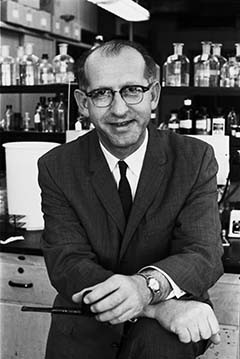Howard Gest, an internationally known scientist widely recognized for his research on microbial physiology and metabolism, especially with photosynthetic bacteria, died in Bloomington, Ind., on April 24, 2012, at age 90 of complications from a stroke.
Howard Gest
At the time of his death, Gest was an active distinguished professor emeritus of microbiology and adjunct professor of history and philosophy of science at Indiana University, where he had served on the faculty since 1966. Before Indiana University, Gest also served on the faculties of Case Western Reserve University and Washington University. He was also a visiting researcher at the California Institute of Technology, Dartmouth Medical School, Stanford University, Oxford University, Tokyo University and UCLA. Gest was twice awarded a Guggenheim Fellowship and was a Fellow of the American Association for the Advancement of Science, the American Society for Microbiology, the American Academy of Microbiology and the American Academy of Arts and Sciences. Gest also served on a number of advisory committees of the U.S. government. Gest’s first wife, Janet, died in 1994 and he is survived by his second wife, Virginia; three sons, Ted, of Washington, DC; Michael, of Boulder, Colo.; and Donald of Tucson, Ariz.; one grandson; and two great grandchildren.

During undergraduate studies at the University of California at Los Angeles (B.A., 1942) Gest spent two summers assisting Max Delbruck and Salvador Luria performing research on bacterial viruses at the Cold Spring Harbor (N.Y.) Laboratory. In 1942, Gest began graduate work on viruses with Delbruck at Vanderbilt University, but World War II interrupted his studies. (Delbruck, Luria, and Hershey shared a Nobel Prize for their work on phage genetics in 1969.) During the war, Gest accepted a position on the Manhattan Project, aimed at developing an atomic bomb, with the eminent physical chemist Charles Coryell. Their research focused on characterization of the radioactive elements formed during uranium fission. During that time, Gest also signed a petition drafted by fellow scientist Leo Szilard urging President Harry Truman to demonstrate the power of the bomb to the world and give Japan an opportunity to surrender before it was used.
When World War II ended, Gest completed graduate work (Ph.D. 1949) at Washington University in St. Louis as the first student of Martin Kamen, a pioneer nuclear chemist renowned as the co-discoverer of carbon 14. During this period, Gest also did research with Alfred Hershey on the fate of radioactive phosphorus during the multiplication of bacterial viruses. That work culminated in the discovery of “P-32 suicide” of bacteriophage. The remainder of his scientific career was focused on microbial physiology and metabolism with photosynthetic bacteria where he was widely recognized for his contributions to this field. In the 1970s, Gest and co-workers undertook some of the first genetic studies on photosynthetic bacteria and in the 1980s he isolated several new genera of photosynthetic bacteria, including Heliobacterium chlorum that represented the first example of a photosynthetic spore forming Gram-positive bacterium. This contribution was recognized by a scientific colleague who named a new species in this genera Heliobacterium gestii.
In the years following his retirement from laboratory research, Gest focused on the history of science, with particular emphasis on the under-appreciated contributions of the English scientist Robert Hooke, with respect to microscopy and other aspects of microbiology. Gest was also a frequent contributor to Microbe and other journals, often criticizing what he considered to be the current overreliance on molecular methodologies to the exclusion of classical microbiology and cultivation-based techniques. He remained an active, independent, and insightful scholar of microbiology and the practice of science in general, right up to his passing. During a remarkable 70-year scientific career, Gest published more than 300 papers and books, including co-editing the 1,300-page “Discoveries in Photosynthesis” (2006) that was described by Current Science as “easily among the most outstanding and valuable books published in the biological sciences in the last 100 years.”
Tribute by:
Carl Bauer, IU Molecular and Cellular Biochemistry Department; Theodore Gest, University of Pennsylvania; and Clay Fuqua, IU Department of Biology
Originally published in Photosynthesis Research, (2012) 112:151-152, and reprinted with permission.
 The College of Arts
The College of Arts